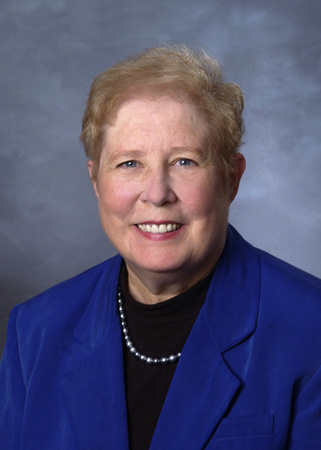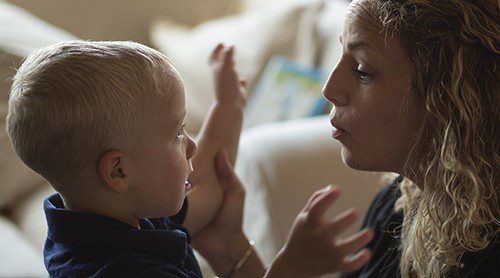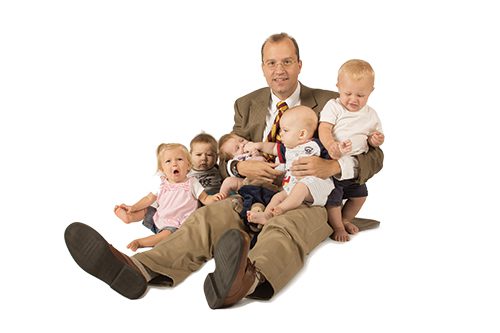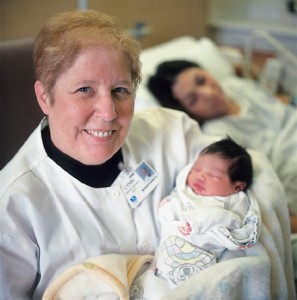
Nursing Professor Lynn Callister shows perinatal nurses how to connect with their patients – from any culture.
NURSING
MARISOL folds her arms tightly across her chest, not wanting to touch the cold steel bars of her hospital bed or rumple the crisp, sterile sheets that cover her bulging belly. Everything seems so unfamiliar. She presses her head back against her pillow, the swelling pain in her abdomen growing nearly unbearable. As she squeezes her eyes closed, a tear of frustration and worry slips down her cheek. She needs help, but she does not know who to ask—or how.
“Hola! Como está?” Marisol’s eyes snap open as she hears the friendly voice of nurse Rosemarie (Susie) Flannery Vega, ’97. Her heart flooding with relief, Marisol immediately begins conversing with Vega in smooth, fluid Spanish, describing the excruciating pain.
This hypothetical example is typical of Vegas’ experiences as a Spanish-speaking nurse at the Utah Valley Regional Medical Center labor and delivery unit. “They are so relieved when they find out that I understand them,” Vega says. “You should see their faces.”
“This is our new reality,” says Lynn Clark Callister, ’64, professor of nursing at BYU. “A labor and delivery nurse on any given day may care for a childbearing woman from Africa who has been ritually circumcised, an Orthodox Jewish family with special needs, a Muslim woman, or a Hispanic woman newly arrived from Central America who doesn’t speak English,” Callister says. “We need to be equipped to provide care for each woman—even if we don’t speak her language.” As the U.S. nursing profession struggles to meet the needs of an increasingly diverse population, Callister is advocating a solution—culturally competent care.
Callister has traveled the world to interview women from many different cultures—Chinese, Jewish, Finnish, Muslim, Guatemalan, Mormon, and Mexican, to name a few—about their childbirth experiences; she then analyzes the interviews and translates the data into information nurses can use to improve the quality of care for their patients. The ultimate goal is “for nurses to be able to connect with the women that they care for and provide a quality experience that is affirming to both the mothers and the nurses who care for them,” Callister says.
“Others are looking into this type of research, but Dr. Callister is head of the pack,” says Susan Gennaro, director of the International Center of Research for Women, Children, and Families at the University of Pennsylvania. “When you look at the number of international studies she has done and the cross-cultural analyses, she is definitely leading the way.”
Providing culturally sensitive care can help women feel better about their birthing experiences, and Callister and her colleagues have discovered that “feeling good” can have tangible effects on the mothers and their families. In fact, Callister reports that thoughtful care by nurses can help prevent postpartum depression, facilitate a positive relationship between husband and wife, enrich the family perspective, and promote feelings of self-actualization in the mother.
In addition to improving the birthing experience, Callister hopes to provide mothers with helpful information. “If we can educate the mothers, provide them with good health care, and empower them with skills and knowledge, then they can make a difference for their families for generations.”
Cultural Competence
First and foremost, Callister encourages nurses to respect their patients’ cultural traditions. “If they want to tie a red thread around a newborn’s wrist, if they want only hot foods after they have their baby, if they want to squat to give birth—why not?” Callister asks. “Instead of treating everyone alike, we should celebrate the differences.”
Callister also advises nurses to learn about different cultures so they can be sensitive to the more subtle nuances and practices of a given culture. “Understanding the culture adds a personal, individualized touch to health care in what can be a bewildering time,” says Robin Kartchner, ’01, one of Callister’s former research assistants.
For example, the Chinese have a practice called zuo yue zi, or “doing the month.” During the first postpartum month, many Chinese women believe that they must bring the warm and cold energies released during birth back into balance in their bodies. Kartchner, who published a study with Callister on Chinese birthing practices, recalls, “I was on the mother/baby unit one day, and I was assigned to a Chinese woman. While I was talking to her, she asked for a glass of warm water. I immediately understood why.” Kartchner asked the woman if she was “doing the month,” and the woman’s face brightened as she nodded, comforted by the mention of the familiar practice. “It was a neat experience to have that connection,” Kartchner says.
Understanding the differences between cultures helps the nurses gauge how to treat their patients. For instance, Callister states, “Knowing that the expression and perception of pain varies across cultures, nurses need to become skilled in assessing childbirth pain by using verbal, nonverbal, behavioral, and physiological parameters.” Finnish women, she reports, often manage the pain of childbirth by non-pharmacological means, including walking, using a rocking chair, acupressure, and laboring in a water pool. “These women seem to perceive pregnancy and birth as developmental tasks and wellness experiences instead of potentially dangerous and overwhelmingly painful processes.” In an interview a Finnish mother recalled, “We were alone, me and my pain. I focused only on the pain and how I could work with the pain.”
In another study Callister found that Guatemalan women also view the pain of birth as an expected part of the experience, and some give birth after drinking only a small amount of cooking oil to “soften the pain.” However, Guatemalan women tend to vocalize their pain, often moaning rhythmically and rubbing their thighs and abdomens to cope. The scene is somewhat similar among Jordanian Muslim women. Callister reports that in their culture, “stoicism is not expected,” and “a high degree of vocalization is considered normal.”
In addition, the husband’s role in childbirth is often dictated by the culture. Callister found that, traditionally, Chinese, Mexican, and Orthodox Jewish husbands are not present during childbirth. One Jewish woman said, “That doesn’t mean that we’re not on good terms or we don’t like each other as much. . . .This is the way it is for us. . . . [My husband] can pray for me and that is my biggest support.”
Callister also cautions nurses to be sensitive to cultural issues when discussing family planning. She found that many Orthodox Jewish women feel it is their duty to have at least two children to replace those who were lost in the Holocaust and perpetuate their people; likewise, some Palestinian Muslim women voiced the desire to have large families to continue the Palestinian bloodline.
Putting the Research to Practice
“In nursing,” Callister explains, “you hope all of your research will have a clinical application. Otherwise, what is the point?” In addition to publishing her research, Callister speaks at professional conferences across the United States and has been appointed to the Association of Women’s Health, Obstetric, and Neonatal Nurses national advisory panel to address global women’s health issues. But perhaps one of the most effective ways she disseminates her knowledge is through her students. Although Vega, Kartchner, and many of Callister’s other students are still novices in the nursing world, they are working to improve the quality of care one patient at a time. Vega now works two jobs—as an on-call OB-GYN nurse for Hispanic patients and in the labor and delivery unit of Utah Valley Regional Medical Center, where, thanks to Callister’s tutelage, she provides care for patients of all cultures.
“It is very rare to have someone who produces such high-quality research and is also such an outstanding educator,” says Gennaro. “She is able to share her research with students and help bring along the next generation.”
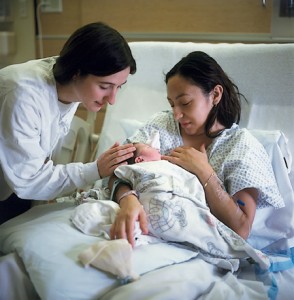
Nursing student Luna Goncalvez Crookston, ’03, from Bahia, Brazil, uses her cultural training and background to better serve patients.
One day, Vega was assigned to a Chinese mother. Callister recalls, “As Susie entered the birthing room, she instinctively noticed the tension in the room.” A quick analysis revealed that the parents-to-be spoke very little English. The doctor couldn’t make the woman understand what he wanted her to do, and the husband was watching helplessly. Vega says, “I just got up really close to her and put my hand on her shoulder, and I went through the motions with her of taking a deep breath and pushing. I showed the husband what he could do to help, and I calmed the doctor down. It ended up being a really beautiful experience.”
Callister finishes the story. “The husband was just thanking her profusely afterwards. He said, ‘I am so grateful. It is so great that you speak Chinese.’ And she said, ‘I don’t speak Chinese.'” The father, touched by Vega’s gentle approach to nursing, truly thought she had spoken his language.
“This is my goal—this is what I hope for,” Callister says as she recalls Vega’s experience. “I want nurses to be able to connect with the women they care for. I want them to be able to transcend barriers in caring. Susie cared. And she showed that even though she didn’t know their language, she could still speak with the language of the heart.”
—E. Liza Richards, ’02
Related Article:
THE MEXICAN PARADOX
By E. Liza Richards, ’02
The most recent study of BYU nursing professor Lynn Clark Callister, ’64, has uncovered a startling fact: the longer a Mexican woman lives in the United States, the more likely she is to have a low-birth-weight baby.
“It really is a paradox,” Callister says. Although newly arrived immigrants’ situation usually includes factors that increase the risk for low-birth-weight infants—including low socio-economic status, lack of education and insurance, inadequate prenatal care, and younger maternal age—they have healthier babies than their more acculturated counterparts. Callister explains that the traditional Mexican culture actually acts as protection for the immigrant women. When the women abandon their traditions and become more acculturated to the U.S. lifestyle, they tend to inherit some of the culture’s worst habits, including drinking, smoking, sexual promiscuity, and illegal drug use. Their once-healthy, nutrient-rich diet is often replaced by one high in sodium and fat. And as their poverty forces the women to leave their home in search of work, the time and effort they are able to dedicate to their role as mothers decreases.
Because the results are harmful for Mexican American mothers and infants, Callister wants to curb the trend. “The whole purpose of this particular research is to design an intervention program where Mexican immigrant mothers teach other Mexican immigrant mothers,” she explains. “They will talk about preserving these values and being proud of the traditional beliefs that are associated with positive health in mothers and their families.”







